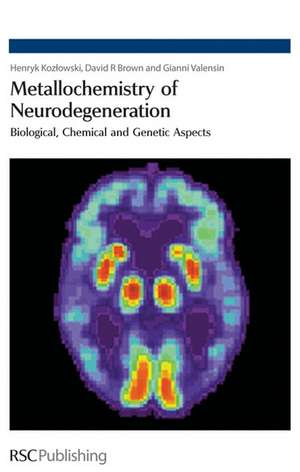Metallochemistry of Neurodegeneration: Biological, Chemical and Genetic Aspects
Autor Henryk Kozlowski, David R. Brown, Gianni Valensinen Limba Engleză Hardback – 4 oct 2006
Preț: 922.54 lei
Preț vechi: 1013.79 lei
-9% Nou
176.53€ • 192.35$ • 148.75£
Cartea se retipărește
Specificații
ISBN-10: 0854043608
Pagini: 294
Ilustrații: Illustrations (some col.)
Dimensiuni: 163 x 238 x 22 mm
Greutate: 0.59 kg
Editura: Royal Society Of Chemistry
Cuprins
Textul de pe ultima copertă
Bioinorganic chemistry has a cross disciplinary approach, applying the principles of chemistry to biological systems. Metallochemistry of Neurodegeneration: Biological, Chemical and Genetic Aspects discusses the rapidly developing area of metals in the nervous system and their role in neurodegenerative disease, such as Alzheimer's, Parkinson's and prion diseases.
Written by leading experts in their fields, each chapter combines elements of genetics, biochemistry and biological inorganic chemistry in its discussion. The book highlights the differences in pathologies of neurodegenerative diseases but also discusses the mechanistic similarities. Sections include: metal ions and prion diseases; metal ions and Alzheimer disease; manganese in brain functioning; metal involvement in Parkinson disease; Cu-Zn superoxide dismutase and familial amyotrophic lateral sclerosis.
This book will appeal to both chemists and biologists at the postgraduate and research level.
